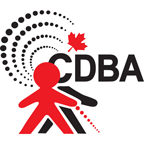Brief History of the Organization
The CDBA was formed in 1975 by parents of children with deafblindness who were attending the W. Ross Macdonald School for Students who are Blind and Deafblind in Brantford, Ontario.
Initially, the CDBA was an advocacy organization representing a small group of children born with deafblindness largely from the congenital rubella epidemic. Its mission has been expanded from advocacy to include service provision, awareness, public education and research. The CDBA is inclusive and represents all Canadians with deafblindness.
Objectives
Many adults and children who are deafblind remain isolated and under-served in Canada. This causes a ripple effect that puts their health and safety at risk, puts tremendous strain on their families and ultimately our communities. CDBA National must continue to broaden our outreach and education efforts to ensure that those who are deafblind and most vulnerable in Canada receive basic services that ensure their well-being.
There is a growing population of seniors. A significant symptom of aging is the high prevalence of combined hearing and visual impairment. This is expected to contribute significantly to the health care concerns of this growing population.
CDBA National has the expertise and thus is in a position to educate the Canadian population of this growing issue and to help prepare this demographic for these implications. More research, education and training is necessary to better prepare health care professionals, family members and other service providers to ensure appropriate services for this demographic who suffer from dual sensory loss.
In fact, a national strategy is needed to ensure that aging and elderly adults continue to be as independent as possible and ensure their health, well-being, ability to communicate and be involved in their communities.
CDBA needs to continue to educate society and governments about the impact of dual sensory loss. The key to ensuring this recognition, and the provision of equitable and quality services throughout Canada, is the declaration of deafblindness as a “unique” disability.
There are ‘rights’ laws which guarantee adequate services and supports for those who are blind and to those who are deaf, but very few of these services would support the needs of the person who is deafblind. Those who are deafblind require access to an Intervenor, someone to be their eyes and ears, allowing them to communicate, develop skills, interact with their environment, and be full participating members of society.
Specific and Recent Accomplishments
Since its inception, CDBA has shown significant progress as an advocacy, service delivery and service facilitating organization. The following are some of its achievements:
- Administering a variety of Intervenor Services programs across the country.
- Instrumental in establishing a network of independent living residences, through its Chapters, in the provinces of Ontario, Manitoba, Saskatchewan and British Columbia. Providing, in the provinces of New Brunswick and Prince Edward Island, through the New Brunswick/PEI Chapter, varying amounts of home-based Intervenor Services to individuals with congenital and acquired deafblindness.
- Providing Intervention services to a number of persons (previously not identified with deafblindness) living at the Manitoba Developmental Centre in Manitoba.
- Produces two editions of the Newsmagazine ‘INTERVENTION’ which is devoted to deafblindness and parent issues. CDBA has been producing this magazine for over 20 years.
- Received funding from Human Resources and Development Canada (HRDC) to: (a) research Late Manifestations of Congenital Rubella in Canada (published 1999) and (b) develop a ‘Registry of Persons with Deafblindness in Canada’. A report on the Registry Project was finalized in the spring of 2001.
- Organized seven Canadian Conferences on Deafblindness (Brantford -1983, Brantford -1986, Winnipeg – 1990, Fredericton – 1993, Vancouver – 1996, Mississauga – 1998, Winnipeg – 2006).
- Hosted the 13th World Conference of Deafblind International, August 05-10, 2003 at the Delta Meadowvale Hotel, Mississauga, Ontario.
